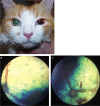Feline systemic hypertension: Classification and pathogenesis
- PMID: 21215946
- PMCID: PMC10845409
- DOI: 10.1016/j.jfms.2010.11.007
Feline systemic hypertension: Classification and pathogenesis
Abstract
Practical relevance: the increased availability of indirect blood pressure monitoring devices in clinical practice over the past decade has highlighted the significance of systemic hypertension in the feline population. Without routine monitoring and appropriate intervention, cats with undiagnosed systemic hypertension may first be presented with sudden-onset blindness as a consequence of either hyphaema or retinal detachment.
Clinical challenges: the primary aim in the early diagnosis and treatment of systemic hypertension is prevention of hypertensive target organ damage (with respect to the eye, kidney, cardiovascular and central nervous systems, in particular). A prerequisite is a knowledge of the pathophysiological mechanisms and disease conditions that may contribute to the development of hypertension. This allows the clinician to determine those cases in which blood pressure assessment and longitudinal monitoring is essential and can assist in determining appropriate therapeutic strategies for control of blood pressure. Recent studies have also begun to explore the relationship that systemic hypertension may have with proteinuria and the progression of kidney disease.
Patient group: the geriatric cat appears most susceptible to the development of systemic hypertension, and monitoring of systolic blood pressure is often advocated as part of a routine health screen in cats over 9-12 years old. Consideration must also be given to cats suspected of having an underlying disease such as chronic kidney disease or hyperthyroidism, or which are receiving therapeutic agents, irrespective of their age.
Evidence base: much of our understanding of the pathogenesis of feline hypertension is extrapolated from studies performed in experimental animal models or in human patients, and interspecies differences are often poorly understood.
Figures






References
-
- Brown SA, Langford K, Tarver S. Effects of certain vasoactive agents on the long-term pattern of blood pressure, heart rate, and motor activity in cats. Am J Vet Res 1997; 58: 647–52. - PubMed
-
- Belew AM, Barlett T, Brown SA. Evaluation of white-coat effects in cats. J Vet Intern Med 1999; 13: 134–42. - PubMed
-
- Kobayashi DL, Peterson ME, Graves TK, Lesser M, Nicols CE. Hypertension in cats with chronic renal failure or hyperthyroidism. J Vet Intern Med 1990; 4: 58–62. - PubMed
-
- Sparkes AH, Caney SMA, King MCA, Gruffydd-Jones TJ. Inter- and intraindividual variation in doppler ultrasonic indirect blood pressure measurements in healthy cats. J Vet Intern Med 1999; 13: 314–18. - PubMed
-
- Franklin SS, Gustin W, Wong ND, et al. Hemodynamic patterns of age-related changes in blood pressure. Circulation 1997; 96: 308–15. - PubMed
Publication types
MeSH terms
LinkOut - more resources
Full Text Sources
Other Literature Sources
Medical
Miscellaneous

